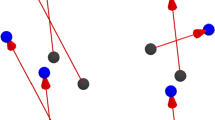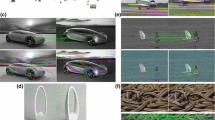Abstract
Suppose two perspective views of four world points are given and that the intrinsic parameters are known but the camera poses and the world point positions are not. We prove that the epipole in each view is then constrained to lie on a curve of degree ten. We derive the equation for the curve and establish many of the curve’s properties. For example, we show that the curve has four branches through each of the image points and that it has four additional points on each conic of the pencil of conics through the four image points. We show how to compute the four curve points on each conic in closed form. We show that orientation constraints allow only parts of the curve and find that there are impossible configurations of four corresponding point pairs. We give a novel algorithm that solves for the essential matrix given three corresponding points and one of the epipoles. We then use the theory to create the most efficient solution yet to the notoriously difficult problem of solving for the pose of three views given four corresponding points. The solution is a search over a one-dimensional parameter domain, where each point in the search can be evaluated in closed form. The intended use for the solution is in a hypothesise-and-test architecture to solve for structure and motion.
Similar content being viewed by others
References
Faugeras, O. D. 1993. Three-Dimensional Computer Vision: A Geometric Viewpoint. MIT Press.
Fischler, M.A. and Bolles, R.C. 1981. Random sample consensus: A paradigm for model fitting with applications to image analysis and automated cartography. Comm. Assoc. Comp. Mach. 24(6), 381–395.
Haralick, R.M., Lee, C., Ottenberg, K., and Nölle, M. 1994. Review and analysis of solutions of the three point perspective pose estimation problem. Int. J. of Computer Vision. 13(3), 331–356.
Hartley, R.I. and Zisserman, A. 2000. Multiple View Geometry in Computer Vision. Cambridge University Press.
Holt, R. and Netravali, A. 1995. Uniqueness of solutions to three perspective views of four points. IEEE Transactions on Pattern Analysis and Machine Intelligence 17(3).
Kirwan, F. 1995. Complex Algebraic Curves. Cambridge University Press.
Maybank, S.J. 1993. Theory of Reconstruction from Image Motion. Berlin: Springer-Verlag.
Nistér, D. 2003a. An efficient solution to the five-point relative pose problem. In Proceedings of the IEEE Conference on Computer Vision and Pattern Recognition, Madison, Wisconsin, Vol. 2. pp. 195–202.
Nistér D. 2003b. Preemptive RANSAC for live structure and motion estimation. In Proceedings of the International Conference on Computer Vision, pp. 199–206.
Nistér, D. 2004. An Efficient solution to the five-point relative pose problem. IEEE Transactions on Pattern Analysis and Machine Intelligence 26(6), 756–770. To appear.
Quan, L., Triggs, B., and Mourrain, B. 2003a. Some results on minimal euclidean reconstruction from four points. J. of Math. Imag. and Vision. To appear.
Quan, L., Triggs, B., Mourrain, B. and Ameller, A. 2003b. Uniqueness of minimal euclidean reconstruction from 4 points. Unpublished article.
Schaffalitzky, F., Zisserman, A., Hartley, R.I., and Torr, P.H.S. 2000. A six point solution for structure and motion. In Proceedings of the European Conference on Computer Vision, pp. 632–648, Springer-Verlag.
Semple, J.G. and Kneebone, G.T. 1952. Algebraic Projective Geometry. Oxford University Press.
Werner, T. 2003. Constraints on five points in two images. In Proceedings of the IEEE Conference on Computer Vision and Pattern Recognition, Madison, Wisconsin, vol. 2. pp. 203–208.
Author information
Authors and Affiliations
Corresponding author
Additional information
Prepared through collaborative participation in the Robotics Consortium sponsored by the U.S. Army Research Laboratory under the collaborative Technology Alliance Program, Cooperative Agreement DAAD19-01-2-0012. The U.S. Government is authorized to reproduce and distribute reprints for Government purposes notwithstanding any copyright notation thereon.
Now at the Center for Visualization and Virtual Environments, Computer Science Department, University of Kentucky.
Formerly at the Research School of Information Sciences and Engineering, Australian National University.
Rights and permissions
About this article
Cite this article
Nistér, D., Schaffalitzky, F. Four Points in Two or Three Calibrated Views: Theory and Practice. Int J Comput Vision 67, 211–231 (2006). https://doi.org/10.1007/s11263-005-4265-x
Received:
Revised:
Accepted:
Published:
Issue Date:
DOI: https://doi.org/10.1007/s11263-005-4265-x




